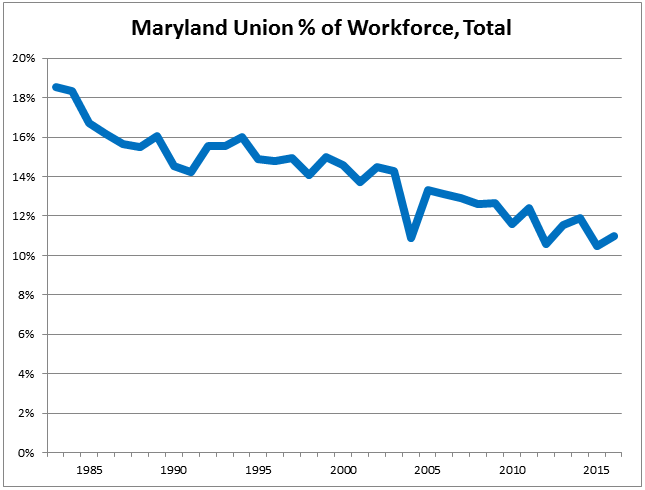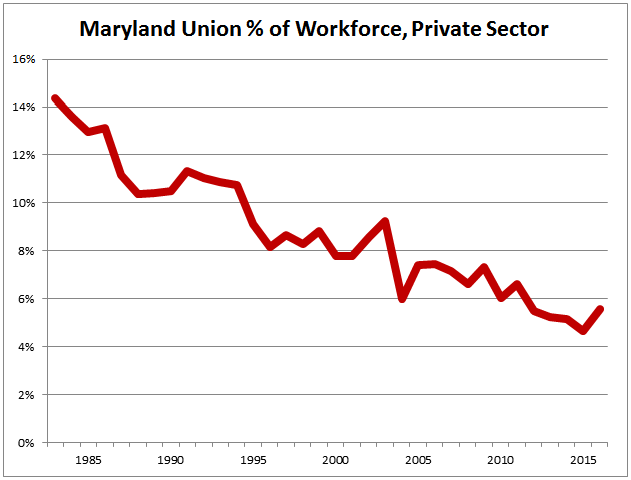By Adam Pagnucco.
Labor Day is the one day of the year when the press discusses one of America’s great historic institutions, the labor movement. Much of the press’s discourse contains annual descriptions of labor’s decline, some sympathetic and some not. Whatever its causes, the story is true: union influence over the economy and American quality of life has been shrinking for decades. Maryland is not immune.
Labor unions are important protectors of working class and middle class people. Unlike political parties, corporations and the press, labor unions were created directly by working people, are governed by leaders those working people elect and are accountable to their memberships. In their heyday from the 1930s through the 1970s, they played indispensable roles in passing laws on social security, civil rights, wage and hour standards and benefit protections. They also reversed the income inequality that prevailed from the Gilded Age through the 1920s and built America’s first large, influential middle class. Under assault by corporate America, hostile politicians, problematic trade policies and economic change as well as – in some cases – handicapped by myopic leadership, they have mostly retreated to the public sector and a few urban strongholds in the Northeast, the Midwest and the West Coast. Many of today’s economic problems, like stagnant wages, vanishing pensions and the increasing dominance of the one percent can be linked to union decline.
The ultimate source of union power is labor’s percentage of the workforce, commonly called union density. When unions establish collective bargaining for a critical mass of employees in a given market, whether industrial, geographic or both, their compensation becomes the standard that even non-union employers must meet. That’s right – even non-union workers benefit from unions. But when unions are unable to organize significant percentages of workers in their markets, they struggle to maintain high levels of wages and benefits in the face of overwhelming non-union competition. Hence, union density is a critical measure of union effectiveness.
According to data from the U.S. Bureau of Labor Statistics, union density in the United States was 10.7% in 2016, down from 24.0% in 1973. Maryland’s union density in 2016 was 11.0%, almost exactly the national average. New York was the only state in 2016 to have a union density of more than 20% while 27 states had densities of less than 10%.
One might suppose that Maryland would be an exception to the rule of declining unionization given the size of its public sector, its long-time control by labor-friendly Democrats and the status of Baltimore as a once-great manufacturing and shipping center. But the truth is that Maryland has mirrored the rest of the country in falling union density. In 1983, 18.5% of its total workforce was in unions. By 2016, that share had fallen to 11.0%.
Union decline in Maryland has been uneven. Protected by laws allowing state and local government collective bargaining and friendly politicians, public sector unions have mostly held onto their power. Their density in 2016 (27.4%) was little changed from 1983 (29.9%). The real fall of Maryland unions has taken place in the private sector. In 1983, 14.4% of Maryland private sector workers were union members. In 2016, that share had dropped to 5.6%.
Private sector union collapse in Maryland has been broad and deep. Construction unions saw their density fall from 16.0% in 1983 to 12.7% in 2016. In the services sector, the drop was from 10.7% to 5.0%. And in private manufacturing, unions in Maryland have been almost obliterated. Union density in that sector fell from 29.2% in 1983 to a shocking 3.9% in 2016.
Progressive elected officials and advocacy groups have focused on measures like minimum wage laws, sick leave laws, tax legislation, health care reform and education funding to help the working and middle classes and reverse income inequality. All of those things matter. But a long-term, sustainable progressive agenda may be impossible without a healthy labor movement. Independent labor organizations are critical to passing good laws, holding corporations and politicians accountable and preserving the gains made by working people against constant attempts to reverse them. Without them, the one percent will continue their march to total domination.
Disclosures: Your author holds two degrees in Industrial and Labor Relations from Cornell University and worked for sixteen years as a strategic researcher in the labor movement.


